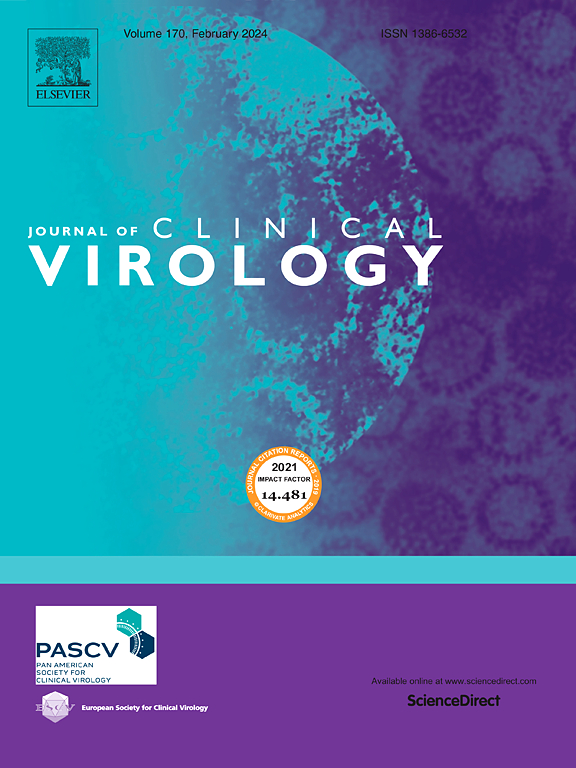诺瓦克病毒GII基因型在亚洲的演变:系统回顾和荟萃分析
IF 3.4
3区 医学
Q2 VIROLOGY
引用次数: 0
摘要
诺如病毒是全球急性胃肠炎的主要病因,其基因型变异影响流行病学和疾病结局。了解不同诺如病毒基因型的分布和流行情况对公共卫生监测和干预策略至关重要。方法对2000 - 2023年亚洲地区诺如病毒基因型进行系统回顾。该审查遵循PRISMA指南,并在PROSPERO注册(ID CRD42024572647)。我们提取了22种基因型的流行率及其随时间的遗传变异的数据。结果该综述强调诺如病毒gi1 .4在亚洲高度流行,特别是在印度、台湾、越南和中国。GII.2在印度尼西亚占主导地位,GII.3在马来西亚、俄罗斯和孟加拉国占主导地位,GII.7在孟加拉国占主导地位,GII.17在中国、台湾和尼泊尔占主导地位,2012年至2016年期间发生了显著的流行病学变化,GII.4从2017年开始复苏。结论诺如病毒在亚洲的基因型分布具有动态特征,既有某些基因型的持续优势,也有显著的区域差异。基因型流行的循环模式,特别是在全球遗传特征1 .4和全球遗传特征1 .17之间的转变,强调需要持续进行基因型监测,以便为有针对性的公共卫生对策提供信息。这些数据强调了诺如病毒流行病学的复杂性以及在监测新出现和再出现毒株方面保持警惕的重要性。本文章由计算机程序翻译,如有差异,请以英文原文为准。
The evolving landscape of Norovirus GII genotypes in Asia: A systematic review and meta-analysis
Background
Norovirus is a leading cause of acute gastroenteritis globally, with genotypic variation influencing epidemiology and disease outcomes. Understanding the distribution and prevalence of different Norovirus genotypes is crucial for public health surveillance and intervention strategies.
Methods
We conducted a systematic review of Norovirus genotypes in Asia from 2000 to 2023. The review adhered to PRISMA Guidelines and was registered with PROSPERO (ID CRD42024572647). We extracted data on the prevalence of 22 genotypes and their genetic variations over time.
Results
The review highlighted Norovirus GII.4 as highly prevalent across Asia, particularly in India, Taiwan, Vietnam, and China. GII.2 dominated Indonesia, GII.3 prevailed in Malaysia, Russia, and Bangladesh, GII.7 in Bangladesh, and GII.17 in China, Taiwan, and Nepal, with notable epidemiological shifts between 2012 and 2016 and GII.4 resurgence from 2017.
Conclusion
The study highlights the dynamic nature of Norovirus genotypic distribution in Asia, with both persistent dominance of certain genotypes and notable regional variations. The cyclic patterns of genotype prevalence, particularly the shifts between GII.4 and GII.17, underline the need for ongoing genotypic surveillance to inform targeted public health responses. The data underscores the complexity of Norovirus epidemiology and the importance of maintaining vigilance in monitoring emerging and re-emerging strains.
求助全文
通过发布文献求助,成功后即可免费获取论文全文。
去求助
来源期刊

Journal of Clinical Virology
医学-病毒学
CiteScore
22.70
自引率
1.10%
发文量
149
审稿时长
24 days
期刊介绍:
The Journal of Clinical Virology, an esteemed international publication, serves as the official journal for both the Pan American Society for Clinical Virology and The European Society for Clinical Virology. Dedicated to advancing the understanding of human virology in clinical settings, the Journal of Clinical Virology focuses on disseminating research papers and reviews pertaining to the clinical aspects of virology. Its scope encompasses articles discussing diagnostic methodologies and virus-induced clinical conditions, with an emphasis on practicality and relevance to clinical practice.
The journal publishes on topics that include:
• new diagnostic technologies
• nucleic acid amplification and serologic testing
• targeted and metagenomic next-generation sequencing
• emerging pandemic viral threats
• respiratory viruses
• transplant viruses
• chronic viral infections
• cancer-associated viruses
• gastrointestinal viruses
• central nervous system viruses
• one health (excludes animal health)
 求助内容:
求助内容: 应助结果提醒方式:
应助结果提醒方式:


